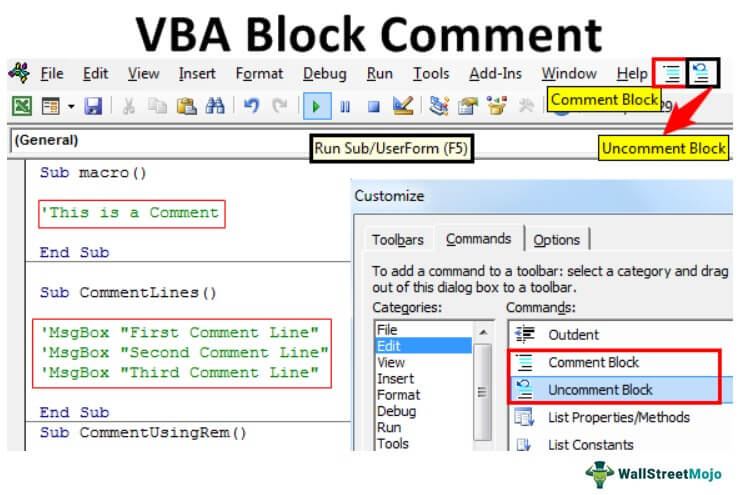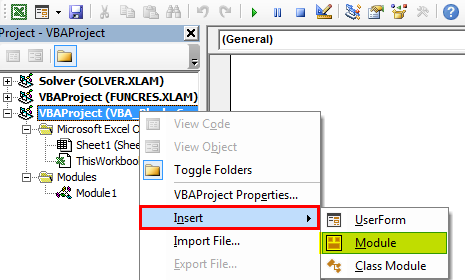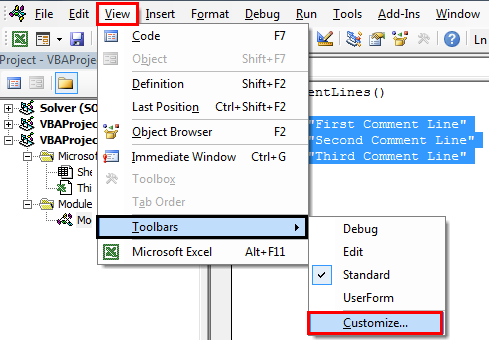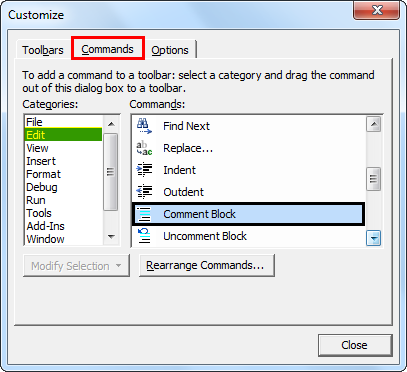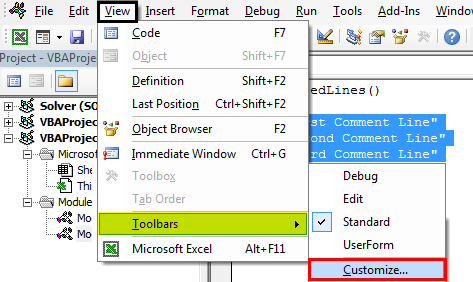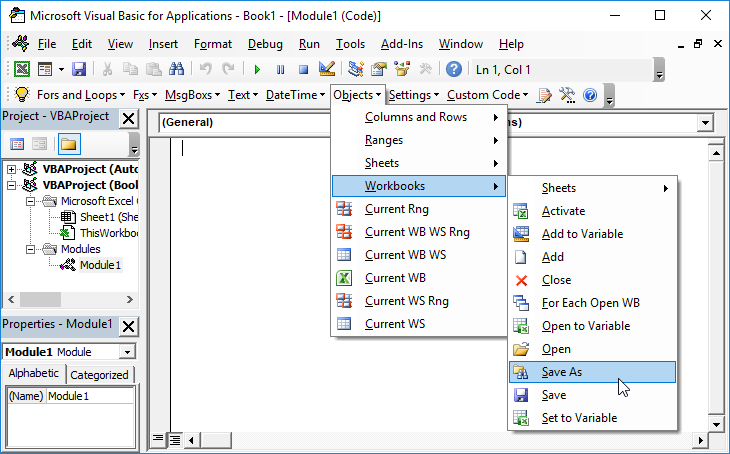Содержание:
- Добавление комментариев в VBA в Excel
- Преобразование строки кода (или блока кода) в комментарий
- Изменение цвета комментария в Excel VBA
- Некоторые рекомендации при работе с комментариями в VBA
При работе с кодированием VBA в Excel вы можете легко добавлять комментарии во время написания кода.
Комментарии в VBA могут быть действительно полезны для новичков, где вы можете добавить комментарий к строке кода (или блоку кода), объясняющий, что он делает. Так что в следующий раз, когда вы вернетесь к коду, вы не потеряетесь полностью и у вас будет какой-то контекст из-за комментариев.
Даже для продвинутых программистов Excel VBA, как только код начинает выходить за пределы нескольких строк, рекомендуется добавлять контекст с помощью комментариев (особенно если есть вероятность, что кто-то другой, возможно, придется поработать над кодом в будущем)
А поскольку это комментарий, VBA игнорирует его при выполнении кода.
В этом коротком руководстве по Excel я расскажу, как добавлять комментарии в VBA, и расскажу обо всех передовых методах, связанных с этим.
Добавление комментариев в VBA в Excel
Чтобы добавить комментарий в VBA, просто добавьте знак апострофа перед строкой, которую вы хотите пометить как комментарий.
Все, что находится после знака апострофа в этой строке, будет считаться комментарием, и VBA превратит его в зеленый цвет (чтобы визуально отличить его от обычного кода)
Добавить комментарий в VBA можно двумя способами:
- Добавьте комментарий в отдельной строке, где эта строка начинается с апострофа, а после него следует текст комментария.
- Добавьте комментарий как часть обычной строки кода, где после кода у вас есть пробел, за которым следует апостроф, а затем комментарий (как показано ниже)
Хотя я видел, что оба они используются программистами VBA, я предпочитаю первый метод, при котором комментарий имеет отдельную строку.
Другой (старый) метод добавления комментария состоит в том, чтобы за комментарием следовало слово «Рем».
Здесь Рем — сокращение от Remark.
Rem использовался во времена BASIC и сохранился в текущих версиях VBA. Хотя хорошо знать, что он существует, я рекомендую вам использовать только метод апострофа при добавлении комментариев в VBA.
Преобразование строки кода (или блока кода) в комментарий
Иногда вам может потребоваться преобразовать существующую строку кода (или блок кода) в комментарии.
Программисты часто делают это, когда работают над кодом и хотят быстро опробовать что-то еще, сохраняя при этом уже написанный код.
Таким образом, вы можете быстро закомментировать строку, попробовать новую, и, если вы хотите вернуть предыдущий код, просто удалите апостроф и преобразуйте этот комментарий обратно в обычную строку кода.
Для строки (или даже нескольких строк) лучше вручную добавить апостроф перед этими строками.
Но если у вас большой блок кода, используйте следующие шаги, чтобы добавить опцию преобразования всего блока кода в комментарий:
- Перейдите на вкладку «Просмотр».
- Перейдите к опции панели инструментов.
- Когда вы наведете на него курсор, вы увидите больше вариантов.
- Нажмите на опцию Edit. Панель инструментов редактирования появится где-нибудь на экране.
- Перетащите панели инструментов редактирования в область панели инструментов, чтобы они закрепились там (в случае, если они еще не закреплены).
- Выберите блок кода, который вы хотите закомментировать
- Нажмите на опцию «Блок комментариев» на панели инструментов.
Вышеупомянутые шаги мгновенно преобразовали бы блок кода в комментарии, добавив апостроф перед каждой строкой в этом коде.
Если вы хотите удалить комментарий и преобразовать его обратно в обычные строки кода, выберите этот блок кода еще раз и нажмите на опцию «Uncomment block» на панели инструментов Edit.
Изменение цвета комментария в Excel VBA
Хотя VB не допускает большого форматирования, он позволяет при желании изменить цвет комментария.
Один из моих студентов курса VBA написал мне по электронной почте и сказал, что возможность изменять цвет комментариев в VBA действительно полезна для людей, страдающих дальтонизмом.
Ниже приведены шаги по изменению цвета комментария в Excel VBA:
- Откройте редактор Visual Basic
- Выберите в меню пункт Инструменты.
- Нажмите на Параметры
- В диалоговом окне «Параметры» перейдите на вкладку «Формат редактора».
- В параметрах цветов кода выберите Текст комментария.
- Измените цвет переднего плана и / или фона
- Закройте диалоговое окно
Когда вы меняете цвет комментария, он также изменяет цвет для всех существующих комментариев в вашем коде.
Некоторые рекомендации при работе с комментариями в VBA
Вот несколько рекомендаций, которые следует учитывать при использовании комментариев в коде VBA.
- Сделайте комментарий содержательным и добавьте контекст. Добавляя комментарий, подумайте, что было бы полезно для нового пользователя, который никогда не видел этот код и пытается разобраться в нем.
- Избегайте чрезмерного комментирования, так как это может сделать ваш код немного загроможденным. Если вы новичок, то можете добавлять больше комментариев, но по мере того, как вы набираетесь опыта в кодировании VBA, вам все равно не нужно будет добавлять много комментариев.
- Для каждой новой подпрограммы или функции рекомендуется добавлять комментарий, объясняющий, что они делают.
- При работе со сложным кодом рекомендуется добавлять комментарии перед условиями и циклами, чтобы вам было легче понять, что вы сделали, когда вы повторно просматриваете код (или когда кто-то другой просматривает код)
В этом уроке я рассказал, как можно добавить комментарии в VBA и некоторые рекомендации по его использованию.
Надеюсь, вы нашли этот урок полезным.
Comments in VBA programming are statements that are not executed or compiled but are only there to provide a brief description of any function, variable, statement, etc. These comments are not mandatory but are used to make the blocks of VBA code more informative, readable, organized, and easy to understand. Also, if we do not wish to delete certain lines of code and neither want them to execute, we can comment on them.
Table of contents
- Excel VBA Comment Block of Code
- How to Comment on Block of VBA Code?
- Example #1 – Comment using Apostrophe
- Example #2 – Using Toolbar
- Step 1: Select the Statements from code.
- Step 2: Click on View -> Toolbars -> Customize
- Step 3: From Customize Window Click on Commands -> Edit, then select Comment Block
- Example #3 – Using REM Keyword
- Example #4 – UnComment the Commented lines using Toolbar
- Things to Remember
- Recommended Articles
- How to Comment on Block of VBA Code?
You are free to use this image on your website, templates, etc, Please provide us with an attribution linkArticle Link to be Hyperlinked
For eg:
Source: VBA Comment Block (wallstreetmojo.com)
How to Comment on Block of VBA Code?
You can download this VBA Block Comment Template here – VBA Block Comment Template
We wish to comment on a single line/statement/block in a VBA code. We must configure the Visual Basic Editor (VBE) to do this.
The Visual Basic Editor can be accessed as follows:
First, go to the Excel Developer tabEnabling the developer tab in excel can help the user perform various functions for VBA, Macros and Add-ins like importing and exporting XML, designing forms, etc. This tab is disabled by default on excel; thus, the user needs to enable it first from the options menu.read more, click “Visual Basic Editor,” or press Alt+F11 to open the “Visual Basic Editor” window.
In doing this, a window opens as follows:
Right-click on the workbook name in the “Project-VBAProject” pane and then click on “Insert” -> “Module” as follows.
Now, we can write our code or procedure in this module:
Code:
Sub macro()
'This is a Comment
End Sub
So, we can see in the above screenshot that when writing this code in the module, when we put or insert an apostrophe before a statement/line, that statement turns into green text and is considered a comment. So, we see that when we wish to comment on a single line, it can precede us with an apostrophe.
We can also use this method to comment on multiple lines by putting an apostrophe before each line as follows:
Example #2 – Using Toolbar
Suppose we wish to skip over and comment on an entire block of code or multiple statements of the code. In such a case, using an apostrophe before each statement would be tedious and time-taking when we have so many statements to comment on. So to do this, there is a built-in option of “Comment/Uncomment Block” in VBA, initially hidden in the toolbar, and we can use it as follows:
Step 1: Select the Statements from code.
Select the statements in the macro/procedure that must comment below.
Step 2: Click on “View” -> Toolbars -> Customize
Step 3: From “Customize” Window Click on “Commands” -> Edit, then select “Comment Block”
It will generate or open a “Customize” pop-up window. Now, click on “Commands” -> “Edit” and then click on “Comment Block” and drag it to the toolbar.
With this, we now have the “Comment Block” icon on the toolbar for easy access.
Now, click on the “Comment Block” from the toolbar as follows:
In doing so, the highlighted statements/lines would now be commented and turn out to be green in color as below:
Code:
Sub CommentLines() 'MsgBox "First Comment Line" 'MsgBox "Second Comment Line" 'MsgBox "Third Comment Line" End Sub
So, we can see in the above screenshot that the green statements will not execute by the macro and will only be treated as comments blocks.
Example #3 – Using REM Keyword
Another method we can use to make a statement/line as a comment is adding the keyword ‘REM’ before it.
Let us see below how this works:
We can see in the screenshot below that when we add the keyword “REM” before the statement: “This is a comment,” it turns out to be green and hence a comment.
Now, let us see how we can use this keyword to comment on multiple lines in the below screenshot.
Code:
Sub CommentUsingRem() Rem This is a Comment Rem This is a Comment Rem This is a Comment End Sub
So, we can see that apart from using apostrophes and “Comment Block,” the keyword we can also use “REM” to comment statements of code or procedure. However, using the keyword “REM” has some limitations:
- Space is mandatory between the keyword “REM”and the start of the statement.
- It always has to be the first word to start with and cannot be used somewhere in the middle of a line/statement to comment on the rest of the line.
Just the way we can comment a block of lines at one go, we can also uncomment the commented lines using the VBE built-in “Uncomment Block” option in the same way as follows:
Select the commented statements in the macro/procedure that we require to uncomment as below:
Now, select View -> Toolbars -> Customize.
It will generate or open a “Customize” pop-up window. Now, click on Commands -> Edit, and then click on Uncomment Block and drag it to the toolbar as follows:
With this, we now have the “Uncomment Block” icon on the toolbar for easy access.
Now click on the “Uncomment Block” from the toolbar as follows:
For doing that, the highlighted statements that commented would now turn into executable statements of the code or procedure and change in color from green to black again as below:
Code:
Sub UncommentedLines() MsgBox "First Comment Line" MsgBox "Second Comment Line" MsgBox "Third Comment Line" End Sub
So, these statements are no longer comments.
Things to Remember
- Comments are brief explanatory statements that we can use to describe the procedures.
- Commenting can be useful in debugging the codes.
- Any statement in the VBA codeVBA code refers to a set of instructions written by the user in the Visual Basic Applications programming language on a Visual Basic Editor (VBE) to perform a specific task.read more that follows an apostrophe is considered a comment.
- As a good programming practice, comments can be used before each code section or variable declarations and functions to describe their purpose.
- The VBA EditorThe Visual Basic for Applications Editor is a scripting interface. These scripts are primarily responsible for the creation and execution of macros in Microsoft software.read more makes the statement’s font color green to indicate that it is a comment.
- The compiler ignores the statement following an apostrophe until the end of the line, unless the apostrophe is present in a string.
- An apostrophe can even be present somewhere in the middle of a line. Text after the apostrophe will be treated as a comment in that case.
The following screenshot illustrates this:
- The comments do not affect code performance.
- The comment symbol: Apostrophe’, or “REM,” has to be used on each line if the comments require more than one line.
- By default, the comments appear as green in the code window.
- The advantage of using apostrophes and “Comment Block” over the keyword “REM” is that they need less memory and space and are also easier to use.
Recommended Articles
This article has been a guide to VBA Comment Block. Here, we learn three ways to comment blocks of VBA codes using 1) Apostrophe, 2) Toolbar, 3) REM keyword, practical examples and a downloadable Excel template. Below you can find some useful Excel VBA articles: –
- VBA Workbook Open
- VBA RegEx
- VBA Workbook Object
Return to VBA Code Examples
This article will teach you how to comment a single line or multiple blocks of code in the VBA Editor. Instead, if you want to learn about how to interact with Excel Cell Comments using VBA read that article.
In Excel VBA, there are several ways to comment lines of a code:
- Single quotation (‘)
- Comment block button in the toolbar
- Adding the Rem keyword.
The easiest way to comment a line of a code is putting a single quotation at the beginning of the line:
'Sheet1.Range("A1").Value = "Test"Notice that in VBA, comments are always displayed as green text.
As you can see in the example, we put a single quotation at the beginning of the first line in the procedure and commented it. If a quotation is put at the beginning of the line, the whole line is commented and will be skipped during execution of the code.
You can also comment part of the code if you put a single quotation somewhere in the line.
In that case code after a quotation will be skipped:
Sheet1.Range("A1").Value = "Test" 'The example of partial line commentingNow we commented only part of the line. This is a good way for writing inline comments in a code.
The second way for commenting a line in a code is using the standard VBA button for comment in the toolbar. In order to display this button, you need to add it: View -> Toolbars -> Edit. Now you can see two buttons in the toolbar: Comment block and Uncomment block.
Simply highlight your desired line(s) of code and click one of the buttons. This will comment/uncomment entire lines. Please note that this method will not allow you to add a comment to the end of a line of code.
You can also use the keyword Rem. In order to comment a line, you need to put this keyword at the beginning of a line:
Rem Sheet1.Range("A1").Value = "Test"Similarly to comment button, the Rem keyword allows you to comment just a whole line of a code, which means that you can put it only at the beginning of a line:
Apart from commenting a single line, we often need to comment multiple lines, a block of code. In order to do this, we can the same standard button Comment Block in the toolbar which we used for commenting a single line. First, we need to select all the lines that we want to comment and then click on the button:
Private Sub CommentEntireBlock()
' Sheet1.Range("A1").Value = "Test"
' If Sheet1.Range("A1") = "Test" Then
' MsgBox "The value of A1 cell is: Test"
' End If
End SubAs a result, the whole block of code is commented.
Similarly, we can uncomment a block, by clicking on the Uncomment Block button in the toolbar:
Private Sub CommentEntireBlock()
Sheet1.Range("A1").Value = "Test"
If Sheet1.Range("A1") = "Test" Then
MsgBox "The value of A1 cell is: Test"
End If
End SubTo enable keyboard shortcuts for commenting:
- Right-click somewhere on empty space in the toolbar.
- Choose Customize option and select the Edit under the categories.
- Find Comment Block in the Commands and drag and drop it next to the existing icons in the toolbar.
- Now you can see the newly added button in the toolbar
- Click on the Modify Selection and check option Image and Text.
- Click again on the Modify Selection and under Name add an ampersand (&) at the beginning of the name, so the name of the button is “&Comment Block”.
Now you can select a single line or a block of code and press Alt+C on your keyboard to comment.
To enable the same option for uncommenting a code, you can repeat the whole process for Uncomment Block command. The shortcut for uncommenting is ALT+U.
VBA Coding Made Easy
Stop searching for VBA code online. Learn more about AutoMacro — A VBA Code Builder that allows beginners to code procedures from scratch with minimal coding knowledge and with many time-saving features for all users!
Learn More!
In the VBA editor of Office (ALT + F11), how do you comment or uncomment a block of code?
ashleedawg
20k8 gold badges73 silver badges104 bronze badges
asked Oct 17, 2012 at 11:28
1
In the VBA editor, go to View, Toolbars, Customise... or right click on the tool bar and select Customise...
Under the Commands tab, select the Edit menu on the left.
Then approximately two thirds of the way down there’s two icons, Comment Block and Uncomment Block.
Drag and drop these onto your toolbar and then you have easy access to highlight a block of code, and comment it out and uncomment with the click of a button!
See GauravSingh’s answer if you want to assign keyboard shortcuts.
answered Oct 17, 2012 at 11:28
RemarkLimaRemarkLima
11.5k7 gold badges38 silver badges53 bronze badges
9
- Right-click on the toolbar and select Customize…
- Select the Commands tab.
- Under Categories click on Edit, then select Comment Block in the Commands listbox.
- Drag the Comment Block entry onto the Menu Bar (yep! the menu bar)
Note: You should now see a new icon on the menu bar. - Make sure that the new icon is highlighted (it will have a black square around it) then
click Modify Selection button on the Customize dialog box. - An interesting menu will popup.
Under name, add an ampersand (&) to the beginning of the entry.
So now instead of «Comment Block» it should read &Comment Block.
Press Enter to save the change. - Click on Modify Selection again and select Image and Text.
- Dismiss the Customize dialog box.
- Highlight any block of code and press Alt—C. Voila.
- Do the same thing for the Uncomment Block or
any other commands that you find yourself using often.
answered May 30, 2014 at 11:55
GauravSinghGauravSingh
1,9351 gold badge12 silver badges11 bronze badges
18
There is a built-in Edit toolbar in the VBA editor that has the Comment Block and Uncomment Block buttons by default, and other useful tools.
If you right-click any toolbar or menu (or go to the View menu > Toolbars), you will see a list of available toolbars (above the «Customize…» option). The Standard toolbar is selected by default. Select the Edit toolbar and the new toolbar will appear, with the Comment Block buttons in the middle.
*This is a simpler option to the ones mentioned.
answered Apr 26, 2015 at 6:56
dePatinkindePatinkin
2,2391 gold badge15 silver badges15 bronze badges
1
Have you checked MZTools?? It does a lot of cool stuff…
If I’m not wrong, one of the functionalities it offers is to set your own shortcuts.
answered Oct 18, 2012 at 5:12
Tiago CardosoTiago Cardoso
2,0371 gold badge13 silver badges31 bronze badges
1
Or just click View, ToolBars, Edit. Then you can select a block of code and then click the Comment or Uncomment toolbar button to do everything in one click.
As an aside, you can Tab/Shift+Tab a block of selected text also. When I was a noobie, I didn’t know that for a long time and would do them one line at a time.
Good Luck!
answered Jun 28, 2015 at 0:53
j2associatesj2associates
1,1099 silver badges18 bronze badges
After adding the icon to the toolbar and when modifying the selected icon, the ampersand in the name input is specifying that the next character is the character used along with Alt for the shortcut. Since you must select a display option from the Modify Selection drop down menu that includes displaying the text, you could also write &C in the name field and get the same result as &Comment Block (without the lengthy text).
answered Jul 6, 2016 at 15:16
An easy way to add buttons to Comment or Un-Comment a code block is:
- Go to View-Toolbars-Customise
- Select the Command tab
- Select the Edit Category on the left
- Drag the “Comment Block” and “Uncomment Block” icons onto your toolbar.
answered Jul 11, 2014 at 22:37
Aaron LelevierAaron Lelevier
19.5k11 gold badges75 silver badges111 bronze badges
1
Steps to comment / uncommented
Press alt + f11/ Developer tab visual basic editor
view tab — toolbar — edit — comments.
answered Apr 18, 2016 at 15:30
0
With MZ-Tools installed, I comment/uncomment blocks in VBE by using the keyboard shortcut
Ctrl+Alt+C (MZ-Tools default)
answered Aug 29, 2019 at 15:46
Once you start writing VBA codes, there’s an important thing that you need to learn along with that and that’s using COMMENTS in your VBA codes.
The point is: Using VBA COMMENT is quite easy and simple, the only thing you need to learn is to do it effectively.
So today, I’ll be sharing with you all the details about using comments in VBA and all the options related to them.
A VBA COMMENT is a green line of text that helps you to describe the written code. In simple words, a comment is a line of text which is not a code and VBA ignores it while executing the code. It’s a good practice (I’d say one of the best) to add comments in your VBA codes.
(Video) Understanding VBA Comments

As I said commenting in a VBA code is one of the best practices and there are a few benefits that come with it.
- Helps you to Document your Work: You can use a comment to describe how code works, which can help you in the future to recall it easily or any other user.
- Track the Changes: If some codes need you to change them frequently you can use comments to track or record changes within the code.
- Describe a Function Procedure: When you write a procedure you can add a comment at the starting to describe the purpose of this procedure and how it works.
- Describe a Variable: Variables are one of the most important things that you need to use while writing a VBA code and you can use a comment to describe a variable.
- Debug Your Code: You can use VBA comments to debug the code by converting code lines into comments for testing.
Steps you need to follow to add a comment in a VBA code:
- First, click on the line where you want to insert the comment.
- After that, type an APOSTROPHE using your keyboard key.
- Next, type the comment that you want to add to the code.
- In the end, hit enter to move to the new line and the comment will turn green.

The moment you do this the entire line of the code will turn green which means that line is comment now.
If you look at the below code where I have used a comment to add a description of the procedure.
You simply need to add an apostrophe before turning it into a comment and VBA will ignore it while executing the code.
The second method is to use the comment block button from the toolbar. This button simply adds an apostrophe at the start of the line.
To use this button, first of all, you need to select the line of the code and then click on the button.

Next to the Comment button, there’s one more button “Uncomment” which you can use to uncomment a line (This button simply removes the apostrophe from the line of the code).
There could be a situation where you need to enter a comment in multiple lines, like a block of the comments.
But here is one thing which you need to note down, every line of comment needs to start with an apostrophe, so if you want to add multiple lines of comments every line should have an APOSTROPHE.
The easiest way is to select all the lines and then use the comment button from the toolbar or you can also add an APOSTROPHE at the starting of each line.

The moment you click the comment button it will convert all the lines into a multi-line comment block.

Update: There’s one thing that I have discovered recently if you have a block of comment line (continuous), you can use a line continuation character (an underscore must be immediately preceded by a space).

In the above example, I have used an apostrophe only at the start of the first line of the comment, the rest two-line don’t have an apostrophe but I have used line continuation character to give a line break at the end of the first line and the second line.
This is the third way to insert a comment into a VBA code. Well, this is not a popular way but still, you can use it. So instead of using an apostrophe, you can use the keyword REM at the starting of a comment line.
REM stands for remarks.

Now, in the above example, I have used “REM” at the start of the line of the code and then the line of the code. But, there’s no button to add REM, you have to type it.
When you record a macro code using the macro recorder, you get an option to add a description before you record it.
So when you open the record macro dialog box, there is a “Description” input box where you can add your comment and then start recording.

And when you open the VBE to see the recorded code, you can see the code which you have added as a comment.
When you add a comment while recording a macro, VBA adds a few apostrophes as blank comments.

This is a quite smart way to use a comment in the same line where you have written code. In the below example you can see that I have three lines of code, where I have added comments after each line to describe it.

So once you complete a line of code you can use enter a comment after that in the same line.
Truly speaking there’s no (by default keyboard shortcut) to use to insert a comment. But thanks to Gaurav, I have found a way to create a shortcut key to insert an apostrophe.
Follow the below steps:
Now you can convert a line into a comment by using the shortcut key Alt + C. And if you want to create a shortcut key for the uncomment button you can simply use the above steps to add the uncomment button to the toolbar and the shortcut key for it will be Alt + U.
VBA gives you an option to change the format of the comment if you want to do so. From the Tools ➜ Options ➜ Editor Format, click on the comment text.

As you can see, I have changed the color of the comment text from green to blue. Now all the comments which I have in the code window are in blue color.














